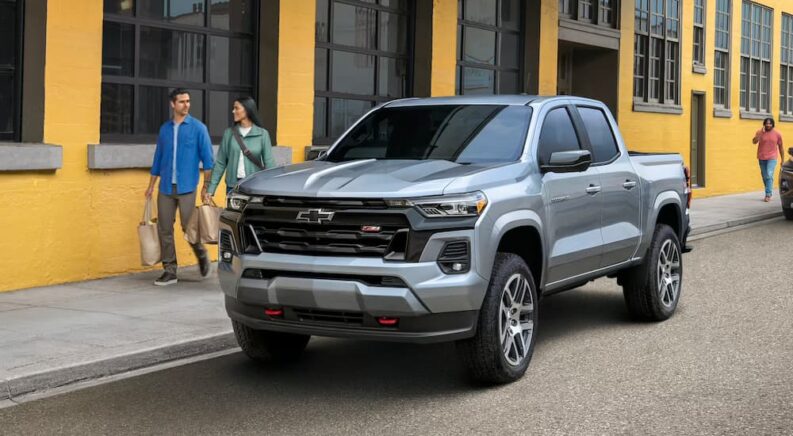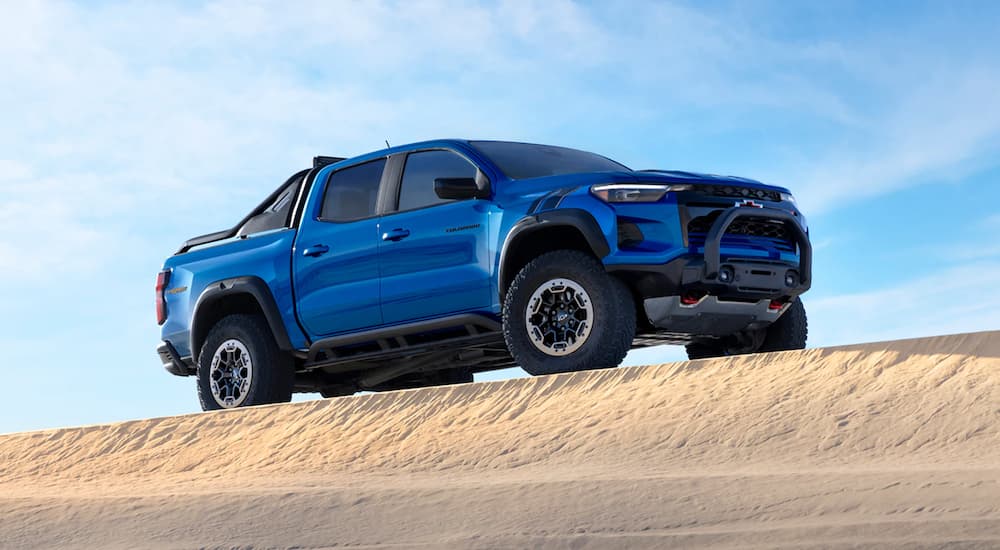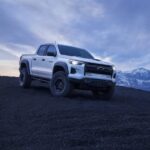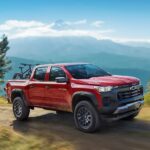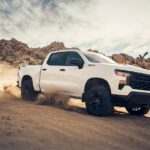When you’re browsing your local Chevy dealer for a dedicated off-road partner, it’s hard to do better than the Chevy Colorado. This midsize pickup combines the raw power of Chevy’s award-winning Silverado 1500 with the practicality of a smaller truck—a formula that’s perfect for any driver looking to explore the road less paved.
The Colorado’s base WT and LT trims are already well-rounded options for daily driving, family outings, and long days at the job site, but for those who take their play just as seriously as their work, this pickup’s dedicated off-road trims are worth a closer look.
It all starts with the Colorado Trail Boss—a value-packed pickup that allows drivers to get down and dirty without sacrificing its road manners. The Z71 kicks it up a notch with some important performance and appearance upgrades, but it’s the Colorado’s ZR2 guise that’s truly the king of the off-road jungle. All three trims are powered by a standard 2.7-liter turbocharged engine with 310 hp, but it’s their long lists of off-road equipment that really set them apart from the crowd.
Chevy also welcomes the new, range-topping Colorado ZR2 Bison to the mix for 2024, collaborating with American Expedition Vehicles (AEV) to widen the truck’s track in a bid to improve your chances of off-road success. With four off-road versions to choose from, it’s easy to get a little overwhelmed, but I’m here to help with a guide to the Colorado’s current off-road options.
The Trail Boss
Starting at $37,000, the Trail Boss is the most affordable of the Colorado’s dedicated off-road trims. While it might lack some of the heavier-duty equipment found on the Z71 and ZR2, this pickup does boast one of the most important attributes of any off-road model: a two-inch factory lift.
Those two inches give the Colorado Trail Boss a total ground clearance of 9.5 inches, which can make all the difference when you’re trying to protect the underbody from the dents, dings, and damage that can come with off-road driving. The Trail Boss is also designed with a track that’s three inches wider than the standard-issue Colorado, improving stability and reducing the chances of a costly rollover.
This trim’s improved ground clearance and 18-inch all-terrain tires give the Colorado improved approach, departure, and breakover angles when compared to the stock trim—important factors for off-road success. A 30.5-degree approach angle lends the ability to ascend a steep grade without worrying about the front bumper, while a 22.4-degree departure angle allows for the same peace of mind on the way down. The Trail Boss’ 21-degree breakover angle means you’re less likely to see the underbody make contact with the ground when you’re at the apex of a hill, giving the Colorado a real leg up over some of its midsize rivals.
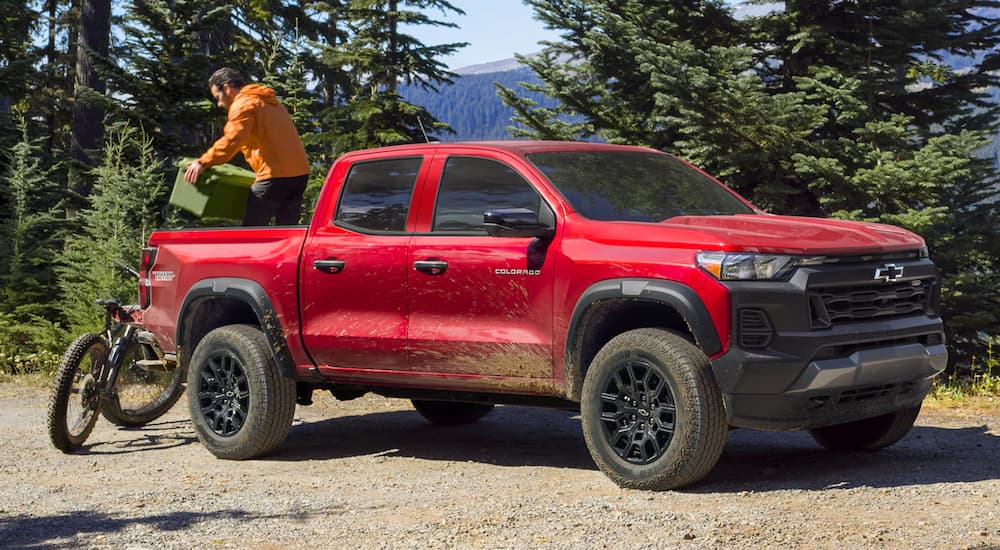
The Colorado Trail Boss also looks every bit the off-roader with black fender flares that add a bit of ruggedness, but it is features like the frame-mounted recovery hooks and the Eaton automatic locking rear differential that represent some of the more substantive additions to this truck’s trail-running arsenal. Of course, the Trail Boss comes standard with four-wheel drive, but Chevy has also thrown in some novel software features that really up this trim’s utility.
Hill Descent Control acts like a sort of off-road cruise control, giving drivers the ability to set their desired speed between 2 and 12 mph. The system also handles the braking and acceleration duties, freeing up the driver to focus on navigating the trail and any obstacles they might encounter, addressing one of the trickiest parts of any off-road excursion.
Every version of the Colorado comes standard with the Drive Mode Selector system featuring three distinct offerings in Tow, Haul, and Eco, but the Trail Boss adds Off-Road and Terrain modes into the mix, too. Off-Road mode ups the pickup’s traction to power through mud, snow, gravel, and other loose surfaces, but Terrain mode is probably the most unique; it allows drivers to leverage a one-pedal driving that’ll bring the Colorado to a stop as soon as you let off the gas. Similar to the system found on many of today’s electric vehicles, this one-pedal mode is ideal for ascending hills or obstacles and can be adjusted for sensitivity through buttons located on the shift lever.
The Z71
“Z71” was originally the code for Chevy’s off-road chassis package that included skid plates, Bilstein shocks, and a host of other off-road features, but the Z71 has since evolved into a full-on trim for the Colorado, Silverado, Suburban, Traverse, and Tahoe. The Z71 starts with all the features you’ll find on the LT trim but adds a long list of off-road upgrades that more than justify the $40,200 starting price.
We’ll start with the appearance-related upgrades, which include 18-inch alloy wheels in a striking Android Dark hue and paired with all-terrain blackwall tires. A gloss black grille fascia and mirror caps give this truck a more mature look, while the two-tone Jet Black/Adrenaline Red upholstery adds a pop of color to the interior. The whole package is tied together by a set of red, frame-mounted recovery hooks in case things go sideways, resulting in a distinctive package that won’t soon be mistaken for the garden-variety Colorado.
The Z71 shares the Trail Boss’ Eaten automatic locking rear differential, which will come in handy if you find yourself in a scenario where one wheel is lacking in traction. In fact, we’d have a hard time recommending setting off for any off-road adventure without a locking rear differential unless you are looking to commit to the off-the-grid lifestyle.
The Z71 does lag behind the Trail Boss in a few important ways, so don’t just assume that the higher prices mean a better truck. With an approach/departure/breakover angle of 29.1/22.3/19.5, the Z71 isn’t quite as well-equipped when it comes to tackling steeper grades. Chevy has also limited the trim’s factory lift to one inch, reducing its overall ground clearance when compared to the Trail Boss.
That said, the Z71 does pack some notable improvements—mainly in the tech department. This truck is outfitted with Hill Descent Control and the Driver Mode Selector system (complete with Off-Road and Terrain modes), but it’s the LED projector headlamps and 120-volt bed-mounted outlet that really up the Z71’s safety and utility cred. The LED projector headlamps should make short work of any dark and gloomy off-road trail, while the 120-volt outlet gives drivers the opportunity to bring any number of electronic gadgets and camping equipment along for the ride.
The ZR2
Since 1994, the ZR2 package has been transforming some of Chevy’s most iconic pickups into readymade off-road machines. Debuting on the Chevy S-10 and GMC Sonoma, this package gave drivers a tantalizing taste of just how rugged some of GM’s smaller trucks could be. The package was discontinued in 2005 but revived in 2017 following the overwhelming positive feedback around a concept model from the 2014 LA Auto Show.
The ZR2 has since become one of Chevy’s breakout stars. A midsize pickup provides the ideal platform for a full off-road build, with the brand pulling out all the stops to make the Colorado ZR2 one of the most well-equipped models in its class. The trim includes upsized 31-inch Goodyear Wrangler Duratrac off-road tires and 17-by-8-inch aluminum alloy wheels that are exclusive to the ZR2—but that’s just scratching the surface.
Throwing on a new set of tires and wheels is quick to up a model’s off-road cred, but Chevy has taken the assignment seriously, modifying the truck’s very dimensions to create something that justifies the $46,800 starting price. Built with a two-inch front and rear lift and a stance that’s 3.5 inches wider than the base Colorado, the ZR2 also features a modified rear axle with a 3.42 ratio as well as front and rear electronic locking differentials for improved traction and new front and rear bumpers that go a long way toward improving ground clearance, but it’s the Multimatic Dynamic Suspensions Spool Valve (DSSV) dampers that really set this truck apart.
Originally designed for high-performance supercars like the Mercedes-AMG GT and the fifth-gen Chevrolet Camaro Z/28, the Colorado ZR2 marked the first time these dampers have been applied to an off-road model. What’s so special comes down to the novel design, which replaces the metal shims one would normally find in the piston with a spring-loaded spool valve. Fluid is able to flow through a small keyhole in the spool valve, which can be altered in size to change the system’s damping characteristics. This design not only improves consistency but also helps to better dissipate heat and prevent accelerated wear and tear.
The Colorado ZR2 is also outfitted with tubular rocker panels, Boron steel skid plates, recovery hooks, a spray-in bedliner, and a one-of-a-kind grille and hood design. This trim adds to the Colorado’s suite of custom driving modes with a new Baja setting that’s ideal for loose, granular surfaces. By altering this truck’s power delivery, stability, and traction, the Baja mode allows drivers to tackle sandy surfaces with confidence.
If the ZR2 still seems a little too pedestrian for your taste, but you still can’t afford to buy a full-on Humvee, there’s a new version that should be just up your alley. The Colorado ZR2 Bison takes everything there is to love about the original and adds a full complement of heavy-duty off-road gear from American Expedition Vehicles (AEV). The Montana-based aftermarket giant has earned its reputation amongst the backwoods set with its off-road and overland parts and accessories—not to mention turnkey off-road vehicles—and its influence on the ZR2 Bison is clear.
This ladder-topping trim sees the addition of 35-inch Goodyear Wrangler Territory Mud-Terrain tires, a full-width steel bumper, full-size spare, steel rock rails, two extra skid plates, and upsized fender flares. The Bison is also 1.5 inches higher thanks to a suspension lift and almost an inch wider than the ZR2 with Chevy shifting the front axle forward by 3.1 inches to make room for the larger tires.
This premium trim also improves on the truck’s breakover and departure angles, but it’s the frequency of the word “Multimatic” that really catches attention. In addition to the DSSV dampers, Multimatic has also been tapped to supply the ZR2 Bison with a set of hydraulic front and rear bump stops. Marketed as Jounce Control Dampers, these bump stops can help to prevent the worst possible outcome when you’re in the mood to let all four wheels leave the ground.
Three Ways to Go Off-Road in a Chevy Colorado
With three levels of off-road performance to choose from, it’s hard to go wrong when picking a trim for the Chevy Colorado. While it’s just as capable as a daily driver, it seems like the Chevy Colorado was always geared toward drivers looking to explore the road less traveled. After all, few trucks on the market have more than half of their trim ladder occupied by off-road versions.
The bowtie brand has managed to produce a set of versatile off-road trims without inflating the price into supertruck territory, making the Trail Boss, Z71, and ZR2 practical choices in a segment where steep inflation is all too common. The Trail Boss might be the least dramatically altered of the bunch, but Chevy has made some substantive changes that elevate this truck well above some of the “soft-roaders” common to today’s market. The Z71 is an even better-appointed choice for those dreaming of off-road glory, but there’s no denying the supremacy of the ZR2 and ZR2 Bison; these two range-topping trims are almost unrecognizable as Colorado variants, but I’m certainly not complaining!

